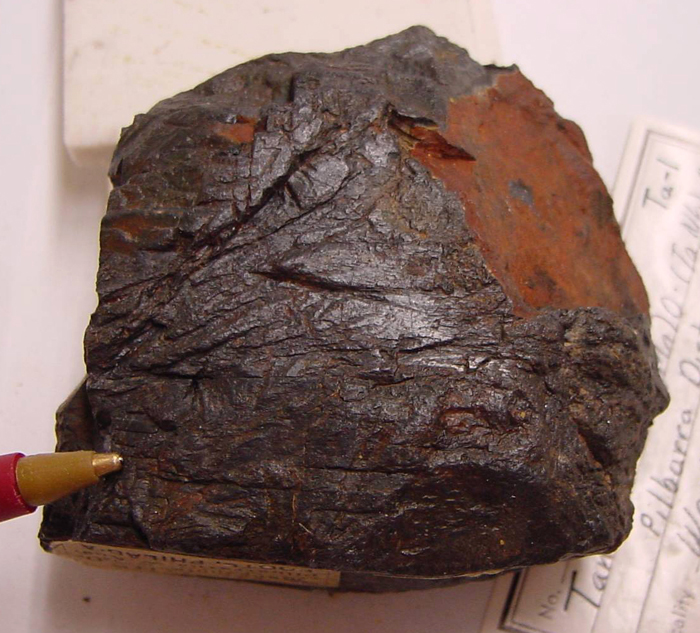|
Tantalum(III) Chloride
Tantalum(III) chloride or tantalum trichloride is non-stoichiometric with a range of composition from TaCl2.9 to TaCl3.1 Anionic and neutral clusters containing Ta(III) chloride include a6Cl18sup>4− and a6Cl14H2O)4. Formation Tantalum(III) chloride is formed by reducing tantalum(V) chloride with tantalum metal. this is done by heating tantalum(III) chloride to 305 °C, passing the vapour over tantalum foil at 600°, and condensing the trichloride at 365 °C. If the condensing region is kept at too high a temperature, then TaCl2.5 deposits instead. The trichloride can also be prepared by thermal decomposition of TaCl4, with removal of volatile TaCl5. TaCl5 can be vapourised leaving behind TaCl3. "Salt-free reduction" of a toluene solution of TaCl5 with 1,4-disilyl-cyclohexadiene in the presence of ethylene Ethylene (IUPAC name: ethene) is a hydrocarbon which has the formula or . It is a colourless, flammable gas with a faint "sweet and musky" odour when pure. ... [...More Info...] [...Related Items...] OR: [Wikipedia] [Google] [Baidu] |
Niobium(III) Chloride
Niobium(III) chloride also known as niobium trichloride is a compound of niobium and chlorine. The binary phase NbCl3 is not well characterized but many adducts are known. Synthesis left, 184px, Structure of NbCl3(dimethoxyethane)(3-hexyne). Nb3Cl8 is produced by reduction of niobium(V) chloride with hydrogen, or just by heating. Salt-free reduction of dimethoxyethane solution of NbCl5 with 1,4-disilyl-cyclohexadiene in the presence of 3-hexyne produces the coordination complex NbCl3(dimethoxyethane)(3-hexyne): : NbCl5 + C6H6(SiMe3)2 + C2Et2 + dme → NbCl3(dme)(C2Et2) + C6H6 + 2 Me3SiCl An impure dimethoxyethane (dme) adduct of niobium trichloride was produced by reduction of a dme solution of niobium pentachloride with tributyltin hydride: :NbCl5 + 2 Bu3SnH + MeOCH2CH2OMe → NbCl3(MeOCH2CH2OMe) + 2 Bu3SnCl Structure Nb3Cl8 has a hexagonal close packed array of chloride ions. Triangles of niobium occur in octahedral spaces in the chloride array. ... [...More Info...] [...Related Items...] OR: [Wikipedia] [Google] [Baidu] |
Tantalum(III) Bromide
Tantalum is a chemical element with the symbol Ta and atomic number 73. Previously known as ''tantalium'', it is named after Tantalus, a villain in Greek mythology. Tantalum is a very hard, ductile, lustrous, blue-gray transition metal that is highly corrosion-resistant. It is part of the refractory metals group, which are widely used as components of strong high-melting-point alloys. It is a group 5 element, along with vanadium and niobium, and it always occurs in geologic sources together with the chemically similar niobium, mainly in the mineral groups tantalite, columbite and coltan. The chemical inertness and very high melting point of tantalum make it valuable for laboratory and industrial equipment such as reaction vessels and vacuum furnaces. It is used in tantalum capacitors for electronic equipment such as computers. Tantalum is considered a technology-critical element by the European Commission. History Tantalum was discovered in Sweden in 1802 by Anders Ekeb ... [...More Info...] [...Related Items...] OR: [Wikipedia] [Google] [Baidu] |
Tantalum(III) Iodide
Tantalum is a chemical element with the symbol Ta and atomic number 73. Previously known as ''tantalium'', it is named after Tantalus, a villain in Greek mythology. Tantalum is a very hard, ductile, lustrous, blue-gray transition metal that is highly corrosion-resistant. It is part of the refractory metals group, which are widely used as components of strong high-melting-point alloys. It is a group 5 element, along with vanadium and niobium, and it always occurs in geologic sources together with the chemically similar niobium, mainly in the mineral groups tantalite, columbite and coltan. The chemical inertness and very high melting point of tantalum make it valuable for laboratory and industrial equipment such as reaction vessels and vacuum furnaces. It is used in tantalum capacitors for electronic equipment such as computers. Tantalum is considered a technology-critical element by the European Commission. History Tantalum was discovered in Sweden in 1802 by Anders Ekeb ... [...More Info...] [...Related Items...] OR: [Wikipedia] [Google] [Baidu] |

